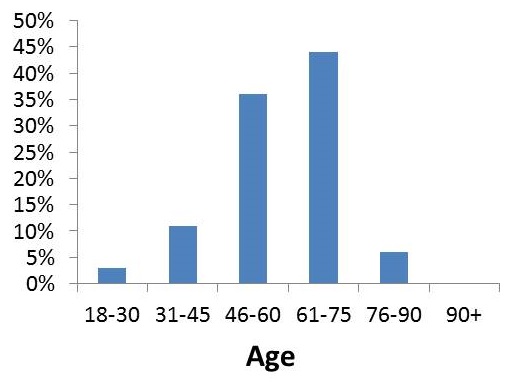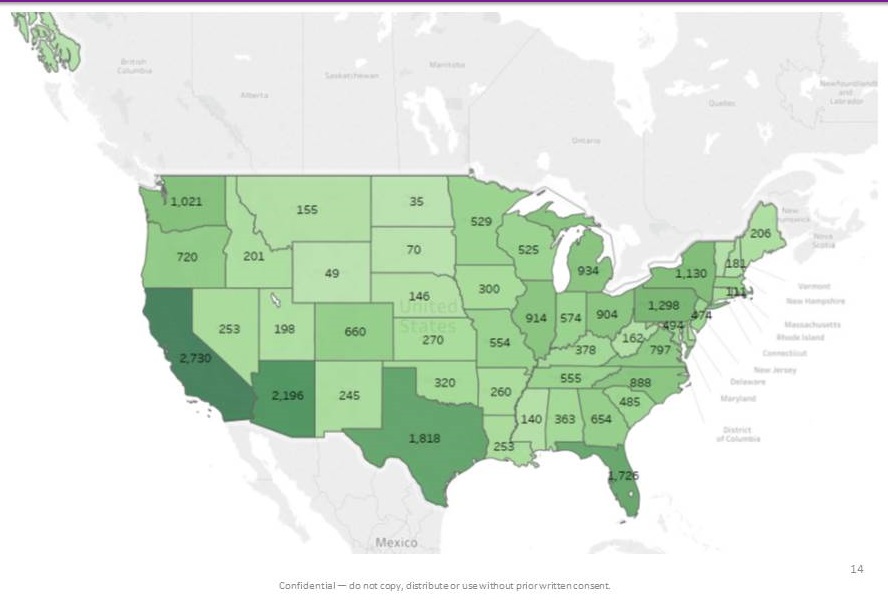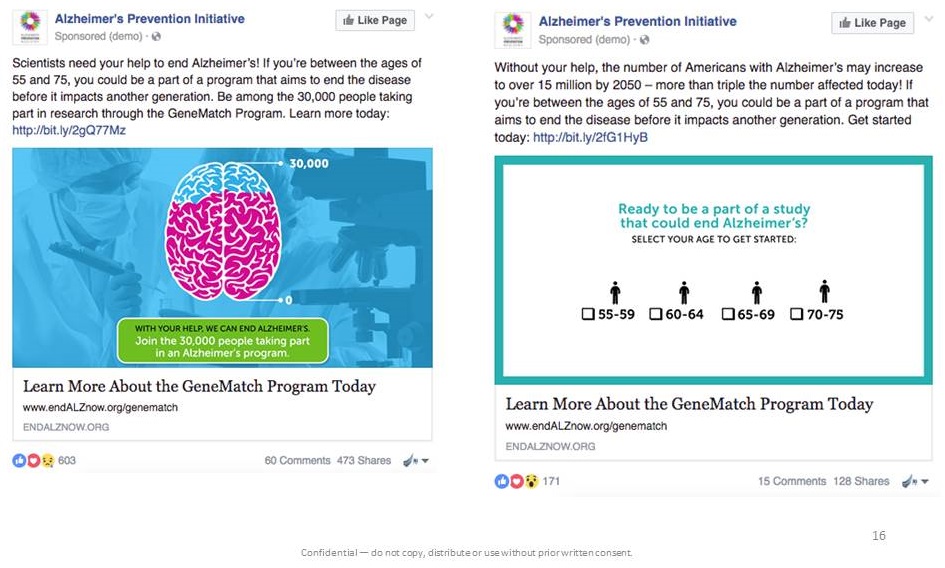Friday, February 3, 2017
Printer Friendly Version in PDF Format (9 PDF pages)
Development and use of registries to accelerate enrollment into Alzheimer's trials
Jessica B. Langbaum, PhD
Principal Scientist, Banner Alzheimer's Institute
Associate Director, Alzheimer's Prevention Initiative
Current Landscape in the United States
- In 2014, ~70,000 participants need to fill 150 Alzheimer's disease (AD) trials
- Requires screening minimum 10x as many participants
- Anticipate a rapid upturn in the number of AD trials in the coming years
- Particularly in hard to recruit populations (healthy older adults at risk for AD, MCI, mild/prodromal AD patients)
- At the same time, recruitment for trials face obstacles, approximately:
- 85-90% of all studies have delays in recruitment
- 30% of studies under enroll
- Only 7% of studies meet enrollment goals in the originally stated timelines
- Under enrollment of African Americans & Hispanic/Latinos in studies limiting generalizability of trial findings
Why a Registry?
- Ability to have thousands of interested individuals available to be contacted for a given study
- GAP has estimated ~7 million adults need to be contacted in order to enroll 4,500 participants!
- Potential to reduce screen fail rate
- Potential to accelerate enrollment into trial, perhaps enhance retention of trial participants
- Online registry can complement and enhance local, grassroots recruitment effort and may be more cost-effective / efficient
- Depending on registry's design, may be able to leverage run-in data for trial
Challenges to Developing Recruitment Registries -- Just the tip of the iceberg!
- If you build it, it does not necessarily mean they will come!
- Why join if you are healthy?
- And those who do join are predominately white, educated & female. Lack of "best practices"
- how much data do you collect at signup? Different thresholds of commitment at entry yield different populations, results.
- Requires a high level of customer service and continued engagement
- Reason why API is still only in English
- Ethics committee / IRB constraints and HIPAA constraints for sharing participant information with enrolling studies/sponsors
 APR is creating "StudyMatch" platform
APR is creating "StudyMatch" platform
- Complicated legal landscape in the US when DNA collection is added
- Creating IT infrastructure is time consuming and expensive; no perfect "out of the box" solution
- Model in US may need adaptation for ex-US
- Funding
Motivators and Barriers to Joining a Registry
- We conducted a national survey in 2012 (1024 US adults) and in 2014/15 analyzed nearly 19,000 conversations from 84 online destinations to try to understand the primary motivators and barriers for joining a registry and participating in trial
- High interest in learning more about registries
- Drivers include helping future generations, driving science forward, taking control of their own lives
- Barriers include concerns regarding privacy/confidentiality, data security, who is "behind" the program
Alzheimer's Prevention Registry
- http://www.endALZnow.org
- Who
- Anyone age 18 and older
- Where
- Anywhere in the world; initial outreach has been focused in the United States
- What & How
- Provide email address, other demographic & contact information at sign up
- Information is kept confidential and secure
- Receive emails with study opportunities, research news
endALZnow.org Website
 |
| https://www.endalznow.org/ |
Enrollee Demographics
- As of January 15, 2017 more than 255,000 enrolled
- 81% of enrollees are female
- 70% self-report a family history of Alzheimer's or other dementia
- 90% self-report not having a diagnosis of a cognitive impairment
 |
Alzheimer's Prevention Registry
How much information are people willing to give about themselves?
And can we use that information to help match them to studies?
GeneMatch: A new program of the Alzheimer's Prevention Registry
- Eligibility requirements:
- Between 55 and 75 years old
- Live in the United States
- Do not have diagnosis of cognitive impairment
- https://www.endalznow.org/genematch
GeneMatch: A program of the Alzheimer's Prevention Registry
- Participants sign up on the website (http://www.endALZnow.org/genematch):
- Review brief, online education module (video or bulleted text)
- Create a GeneMatch account
- Electronically sign an informed consent
- Provide demographic information
- Participants receive a cheek swab kit in the mail approximately 2 weeks later
- Participants complete the cheek swab at home and send it back in a pre-paid postage envelope along with the laboratory requisition form to the lab
- CLIA-certified lab analyzes the swab and genetic information is stored in a secure database not viewed or accessed by GeneMatch staff
- GeneMatch does NOT disclose genotype results to participants
- APOE genotype is used to help match people to study opportunities
GeneMatch Partner Sites
- Numerous Generation Study Sites are GeneMatch partner sites (aka, performance sites)
- Requires institution to approve WIRB as IRB of record and site investigator as program sub-I
- Not all institutions are willing to opt-in, with varying points of resistance
- Allows for buccal swab kits to be distributed and completed on-site
- Benefits:
- Reduces time between enrollment and when APOE results are in the database
- Allows sites to boost GeneMatch enrollment in their catchment area
GeneMatch Metrics
- 31,149 enrolled as of January 24, 2017
- GeneMatch Participant Demographics:
- 70% female
- ~4-5% APOE
 4/
4/ 4
4 - ~30% APOE
 3/
3/ 4
4
- Promoting the API Generation Study to GeneMatch members:
- 264 invited to the study
- 123 accepted their invitation
- 1 declined
GeneMatch -- Enrollment by State (as of 16-January 2017)
 |
Facebook Advertising: 2016 Success Story
- Over 16,000 new GeneMatch members in Q4 2016
- The result of targeted Facebook campaign
- 21% of people who clicked on an ad completed the GeneMatch enrollment process
- The most successful creative concepts were those that utilized social pressure and those that contained elements that have been shown to drive high click-through rates (i.e. polling boxes)
- Average cost $2.88/enrolled
- The result of targeted Facebook campaign
GeneMatch -- 2016 Advertising
 |
Potential Solutions
- Increase participation of underrepresented populations
- Overhaul of content and messaging to ensure clear, accessible language
- More approachable for low literacy English speakers, which will likely enhance usability for higher-literacy users
- Translate content into other languages, starting with Spanish
- Overhaul of content and messaging to ensure clear, accessible language
- Development of a repository for screen failed participants
- Not sponsor specific
- Contains reasons for screen fail (e.g., SUVR value
 amyloid positive) and ability to re-contact participants for other studies
amyloid positive) and ability to re-contact participants for other studies
- National IRB oversight of registries, willingness to approve motivational (not overpromising) messaging. Examine HIPAA constraints and potential solutions
- Federal funding for registries that provide a shared recruitment resource
February 3, 2017 -- Advisory Council Meeting #23
The meeting was held on Friday, February 3, 2017, in Washington, DC. The theme of this Advisory Council meeting was clinical trials for Alzheimer's disease and related dementias and recruitment challenges. Additional afternoon presentations included updates on progress towards a Care and Services Summit, federal workgroup updates, and preparation for the Advisory Council's 2017 Recommendations, due in April 2017. Material available from this meeting is listed below and is also available at https://aspe.hhs.gov/advisory-council-alzheimers-research-care-and-services-meetings#Feb2017.
Comments and questions, or alerts to broken links, should be sent to napa@hhs.gov.
General Information
-
Agenda -- [HTML Version] [PDF Version]
-
Meeting Announcement -- [HTML Version] [PDF Version]
-
Meeting Summary -- [HTML Version] [PDF Version]
-
Public Comments -- [HTML Version]
Handouts
-
Panelist Bios -- [HTML Version] [PDF Version]
Presentation Slides
-
2017 Recommendations -- [HTML Version] [PDF Version]
-
Alzheimer's Association TrialMatch -- [HTML Version] [PDF Version]
-
Clinical Services Subcommittee Federal Update -- [HTML Version] [PDF Version]
-
Clinical Studies Recruitment Strategy -- [HTML Version] [PDF Version]
-
Development and Use of Registries to Accelerate Enrollment into Alzhiemer's Trials -- [HTML Version] [PDF Version]
-
Long-Term Services and Supports Committee Update -- [HTML Version] [PDF Version]
-
National Recruitment Strategy -- [HTML Version] [PDF Version]
-
NINDS Update -- [HTML Version] [PDF Version]
-
Randomized Controlled Trials for Alzheimer's Disease -- [HTML Version] [PDF Version]
-
Strategies to Facilitate Recruitment and Screening for Alzheimer's Clinical Trials -- [HTML Version] [PDF Version]
-
Transforming AD Therapy Development -- [HTML Version] [PDF Version]
-
Update National Research Summit on Care, Services and Supports for Persons with Dementia and Their Caregivers -- [HTML Version] [PDF Version]
